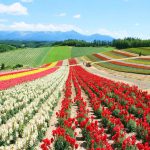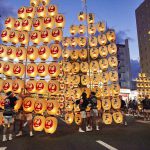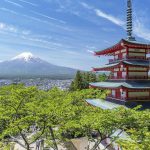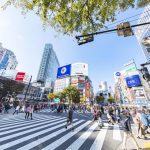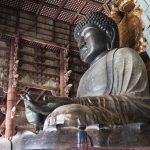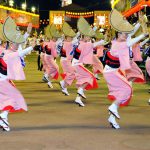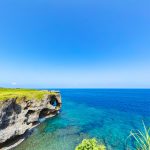Kyushu
The Kyushu region is located in the southwestern part of Japan and consists of seven prefectures: Fukuoka, Saga, Nagasaki, Oita, Kumamoto, Miyazaki, and Kagoshima. There are smaller islands, such as Tsushima, Goto, and the Nansei Islands (also known as the Ryukyu Islands) that run from north to south, off the coast of Kyushu. The climate is mild due to the influence of the warm Kuroshio Current and Tsushima Current. Many volcanoes are located there including Mt. Aso, Mt. Sakurajima, Mt. Unzen, and others, and the region is one of the leading hot springs areas in Japan. The agricultural and fishing industries are successfully balanced throughout Kyushu; livestock farming is particularly productive in the south. In the early 20th century, the government-operated Yahata Steel Works was built in Kitakyushu and became the driving force of modernization in Japan. Presently, Kyushu’s most thriving industries include automobile manufacturing, semiconductors, and food production.
Since ancient times, Kyushu is an area that has had a rich, long history. Due to its geographic proximity to other nations on the Asian continent (about 200 km to Busan, Korea; and about 1,000 km to Shanghai, China), notable cultural influences can be found there. The people of Kyushu are friendly and kind, and the “Southern Hospitality” found there is a large part of its charm.
Fukuoka
Fukuoka City, located near the Korean Peninsula, has prospered from trade throughout the continent since ancient times. It is the largest city in Kyushu, and can be characterized as both traditional and modern. The city has a rich food culture. The popular local foods are Hakata ramen, known for its tonkotsu (pork bone) flavored broth; motsu nabe (hotpot dish with tripe, vegetables, and tofu); fresh seafood sushi; and yakitori (skewered chicken). There are many highly-acclaimed restaurants and around 100 nighttime food stalls, which make the city a gourmet destination.
Hakata Gion Yamakasa is a festival of the Kushida Shrine’s Shinto rituals held annually in July. It is said to have originated in 1241, when the priest of Jyotenji Temple sprinkled holy water on the streets of Hakata to suppress a plague. The Oiyama Festival, which is held early in the morning on July 15, the last day of the festival, is a must-see event. Men in happi coats and loincloths carry a portable shrine called the “Kakiyama,” and run through the streets of Hakata. Other festivals held in Fukuoka City include the Hakata Dontaku Port Festival, Hojo-e, and Tokaebisu Shrine New Year Festival.
The Kawachi Wisteria Garden in Kitakyushu City is a must-visit destination, with an impressive 100-meter-long wisteria tunnel that is at its peak between April and May. Kitakyushu is known as a city of anime, and is one of Japan’s 88 “sacred lands” for anime enthusiasts. The Kitakyushu Manga Museum displays mural paintings and manhole covers decorated with anime and manga designs. Another popular event held in this city is the Kitakyushu Pop Culture Festival.
Other highlights in Fukuoka include Hakata dolls; Hakata textiles; Kurume Kasuri textiles; the Yame area, which produces high-quality tea; Munakata Taisha Shrine, which is devoted to the three goddesses who are the protectors of maritime traffic, and daughters of the God of Mariners; and Ozuka Ancient Tomb, an ornately decorated burial grave built in the 6th century.
Saga
Located in the historic castle town of Karatsu, Niji No Matsubara, a 5-km-long road with more than one million pine trees, is one of the three major pine groves in Japan. From the observatory on Mt. Kagami (284 meters above sea level), you can see Niji No Matsubara in its entirety, along with the spectacular view of Karatsu Bay, which is overwhelming in scale. Yachting is very popular in Karatsu Bay, and many world championship competitions have been hosted there. Many of Japan’s notable yacht racers, including some Olympians, are from this area.
Karatsu is famous for its pottery, which has been used for tea ceremony since ancient times. There are about 70 kilns still existing in the city. Arita and Imari are also famous pottery towns in Saga Prefecture. Arita pottery was exported to Europe in the 17th century under the name of “Imari,” and attracted royalty and aristocrats. It is still popular as one of the leading porcelain brands in Japan.
Built in 1687, Yutoku Inari Shrine is one of the three major Inari shrines in Japan, and is known for its impressive vermillion-lacquered main hall that was built into the slope of the mountain. From the main hall, you can walk through a series of torii gates to reach the inner sanctuary at the top of the mountain, where you can enjoy a spectacular view.
The Ariake Sea, which straddles the southern part of Saga and other prefectures, is the largest bay in Kyushu, where seaweed cultivation thrives. Not only does it boast the largest production of seaweed in Japan, but the seaweed is also top-quality. The seaweed has very good flavor, and is distributed to many high-end restaurants and sushi bars.
Nagasaki
Nagasaki is the city where the second atomic bomb was dropped on August 9, 1945, following Hiroshima. There are various related sites, such as the Peace Memorial Park that is devoted to hope for world peace; the Nagasaki Atomic Bomb Museum that educates about the damage caused by the atomic bomb, and the situation in Nagasaki at that time; and the Hypocenter Park that marks the location where the atomic bomb was dropped.
During the Edo period, Japan adopted a national isolation policy that restricted trade with foreign countries, and prohibited Japanese citizens from traveling abroad. However, Nagasaki became the only foreign contact point with the Netherlands and China. On Dejima, where trade with the Netherlands was conducted, the island serves as a museum where the streets and buildings of the old days have been restored, and visitors can learn about the circumstances of those times. In the city of Nagasaki, there are various buildings and events that relate to China, such as Chinatown; Confucius Temple; Nagasaki Kunchi; and the Lantern Festival.
Due to the full-scale prohibition of Christianity resulting in the suppression of Christians in the 17th century, many fled to the remote islands of Kyushu, and continued to practice their faith in secrecy as “hidden Christians.” There are various remaining settlements, churches, and other sites that pertain to the hidden Christians, including the islands of Hirado, Nozakijima, Kashiragahama, Narushima, Kuroshima, and the town of Sotome. Many people visit these sites on pilgrimages, including the Oura Tenshudo Church (Basilica of the 26 Holy Martyrs of Japan). These sites are registered World Heritage Sites of the Hidden Christian Heritage in Nagasaki and Amakusa regions.
Other destinations include the Iki and Tsushima islands, that have served as important continental trading posts since ancient times, and have nurtured their own unique culture; the Unzen Nita Pass, known for its autumn foliage and frost-covered trees in the winter; the night view of Nagasaki from the beautiful Mt. Inasa; and Battleship Island, where a once-prosperous undersea coal mine remains intact.
Oita
The Kunisaki Peninsula is circular in formation, and located in the northeastern part of Oita Prefecture, where the culture of Rokugo Manzan (a unique fusion of Shinto and Buddhism) was born. Fukiji Temple built in 718, a national treasure, is the oldest wooden building in Kyushu, and the beauty of its autumn foliage is truly exceptional. Other points of interest include the Kumano Magaibutsu, a group of stone Buddhist sculptures that have been carved into the rocky surface, and can only be reached by climbing a series of uneven stone steps; Monjusenji Temple, where the Manjushri Bodhisattva is enshrined; and Futagoji Temple, which is the main temple of Rokugo Manzan.
Beppu is one of the most popular hot springs areas in Kyushu, boasting the largest amount of hot spring water in Japan. You can experience various hot springs, such as Kannawa Onsen with its old town atmosphere; Myoban Onsen, known for its mud hot springs with soothing properties and benefits for beautiful skin; and Takegawara Onsen, which is a symbol of Beppu with its quaint Karahafu-style (wave-shaped roof) building and hot sand bath.
Yufuin Onsen extends along the foot of Mt. Yufu, also known as Bungo Fuji. There are no entertainment districts or large high-rise hotels, which is unusual for a hot springs area. However, many traditional-style luxury inns can be found there, such as Yufuin Tamanoyu, Sanso Murata, and Kamenoi Besso.
The Yamanami Highway, connecting Yufuin to Aso, is a mountain road with a total length of about 50 km. It is a scenic road with a magnificent view of the mountains and grasslands of Kokonoe. There are marshlands, water sources, hot springs, and ranches in the surrounding area, and it is a road that you will definitely want to travel while driving or touring the region.
Kumamoto
Mt. Aso is located in the center of Kyushu, and is an active volcano with the world’s largest caldera consisting of an outer ring of mountains with a circumference of 128 km. The view from Daikanbo observatory overlooking the volcano’s outer rim is breathtaking. The volcano is still active, with occasional plumes. The five peaks rising from the caldera are called Aso Godake. You may take an up-close view of the crater of Mt. Nakadake (one of the five peaks), as long as there are no safety restrictions. Also recommended are Kusasenrigahama, with a spectacular view of the great prairie; Komezuka, a cone-shaped volcano; Sensui Gorge, where the beautiful pink Miyama Kirishima (Kyushu azaleas) bloom in early summer; and Isshingyo Park with its famous giant cherry blossom tree, that has continued to bloom for over 400 years.
Kurokawa Hot Springs is located on the north side of Mt. Aso, and each of the inns has an open-air bath with its own distinctive atmosphere. The town’s people have coordinated their efforts and worked tirelessly to create a pristine landscape. The streets are very beautiful, and visitors are sure to enjoy the relaxing and tranquil setting.
Amakusa, consisting of about 120 small and large islands in the western part of Kumamoto Prefecture, is an area rich in nature and culture. Highly recommended are Oe Church, which was built after the ban on Christianity was lifted; and Sakitsu Church, located in a fishing village, which is a registered World Heritage Site. You can also enjoy Goshoura, where dinosaur fossils have been discovered; Itsuwa Town, where you can see dolphins almost all year round; and local gourmet seafood, such as shrimp and sea bream.
Other points of interest include Kumamoto Castle, one of the three most famous castles in Japan with beautiful stone walls; and Kamishikimi Kumanoimasu Shrine, which was the setting for the popular anime film “Hotaru no Mori e” (Into the Forest of Fireflies’ Light).
Miyazaki
Takachiho, located in the mountains of the northern region of Miyazaki Prefecture, is an area steeped in mystery, and associated with many mythological shrines and legends. Takachiho Gorge is seven km long with cliffs that were formed by lava that flowed from Mt. Aso, eroded and cooled by rain water. The beauty of Manai Falls is extraordinary; you can see the waterfall from the walking trail that leads to the bottom of the gorge, or by traveling down the river on a rental boat.
Takachiho Shrine, which is said to have been built about 1,900 years ago, is known for its spiritual spots, including the “Married Cedars” (two cedar trees with their roots fused underground), said to grant wishes for a blissful marriage and prosperity for the family; and the Shizumeishi Stone that will ease your worries, and bring peace. There is also a Kagura hall on the grounds of the shrine, where Takachiho No Yokagura, a national important intangible folk cultural asset, is held every night for about an hour.
Amano Iwato is a shrine with a sacred forest atmosphere, consisting of East Hongu, West Hongu, and Amano Yasukawara Shrine. After a short walk from Amano Iwato Shrine’s West Hongu, along the Iwato River, you will find the cave of Amano Yasukawara, where eight million gods are said to have gathered to confer when the world was plunged into darkness. There are countless piles of small stones placed along the riverbed by worshippers. It is said that if you pile up the stones while praying for a wish, your wish will come true.
The Kunimigaoka Observatory, a 10-minute drive from Takachiho, is located on a hill that rises 513 meters high. The hill is famous in mythological lore. A sea of clouds can be seen early in the morning from autumn to winter, so be sure to try catching it on the first morning of your stay in Takachiho.
Other points of interest include Saitobaru Ancient Tombs, one of Japan’s leading burial mound sites, with more than 300 mounds, and is also famous for its stunning flowers; and Udo Jingu Shrine, whose main shrine is located in a cave on the cliffs of the Nichinan coast.
Kagoshima
Mt. Sakurajima, one of the world’s most active volcanoes, is a powerful symbol of Kagoshima; its smoke rises almost daily. For the best views of Mt. Sakurajima, we recommend the Shiroyama Observatory, where you can enjoy a panoramic view of Mt. Sakurajima and the city of Kagoshima; and the Yunohira Observatory, where you can see the mighty Mt. Sakurajima looming right before you.
Yakushima, a Natural World Heritage Site, has 46 1,000-meter-high mountains, including Mt. Miyanoura-dake, Kyushu’s highest peak, measuring 1,935 meters above sea level; the view of the island from the sea is breathtaking. Due to its abundant rainfall, it is said to “rain 366 days a year,” and has a climate that ranges from subtropical to subarctic. 1,500 species of flora can be found there, and 40 species native to Yakushima have been identified, making the island an amazing natural treasure trove. Visitors will be overwhelmed by the island’s beauty and natural wonders, including Jomon cedar trees, estimated to be 2,000 to 7,200 years old; beautiful valleys with countless moss-covered forests and clear streams; Shiratani-Unsui Valley, and Senpiro Falls with a 60-meter drop from a huge granite monolith. The island is also home to many animals, including monkeys, deer, and sea turtles.
The Satsuma Peninsula, located on the southwestern tip of Kagoshima, offers many attractions such as Ibusuki, known for its sand baths; the beautiful cone-shaped Mt. Kaimon, nicknamed “Satsuma Fuji”; Chiran Peace Museum for Kamikaze Pilots; Chiran Buke Yashiki, known as “Satsuma’s Little Kyoto”; Chiran Tea Plantation; and Kamafuta Daimyojin Shrine, where people pray with traditional rice pot lids on their heads.
Other places to visit in Kagoshima include Mt. Kirishima with its many hiking trails; Tanegashima Island and Uchinoura where Japan’s space centers are based; the tropical Amami Islands; and the Tokara Islands, known for beautiful oceans, unique customs and unusual festivals.


